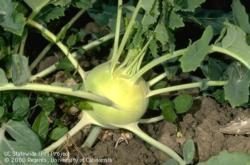Kohlrabi
UC Links

The Basics
Kohlrabi is a member of the cabbage family and is grown for its edible, bulb-shaped, stem. Often mistaken for a root plant, the bulb sits just above the soil. The taste and texture are similar to the stems of broccoli but is juicier and crisper.
When to plant: Direct seed or transplant February–March, September–October (maybe August). For transplants, allow 6 weeks from seeding to transplanting.
Harvest window: Harvest when young and tender. Kohlrabi left too long can become tough and develop off flavors. Kohlrabi leaves are also edible.
Care overview
- Kohlrabi is a fast grower, usually ready to harvest within 8 weeks (variety and weather dependent). Use succession planting to space out your harvest.
- An extended cool period followed by warmth can cause the plants to bolt (send up a flower stalk) which also causes them to get woody and tough.
Recommended Varieties for Santa Clara County*
Note: The external color of the bulb can be white or purple, but the flesh will still be white.
| Kohlrabi Duo, Hybrid | The white flesh is deliciously sweet and juicy. Can be eaten raw or cooked. Mix of green Kongo and purple Kohlibri varieties. 8–10 inches tall. Plant 4–6 inches apart. |
Other recommended varieties: Early Purple Vienna, Kohlibri, White Vienna
* Many other varieties may also do well here in Santa Clara County. This list is based on UC Master Gardener trials, taste tests, and feedback from local growers.






